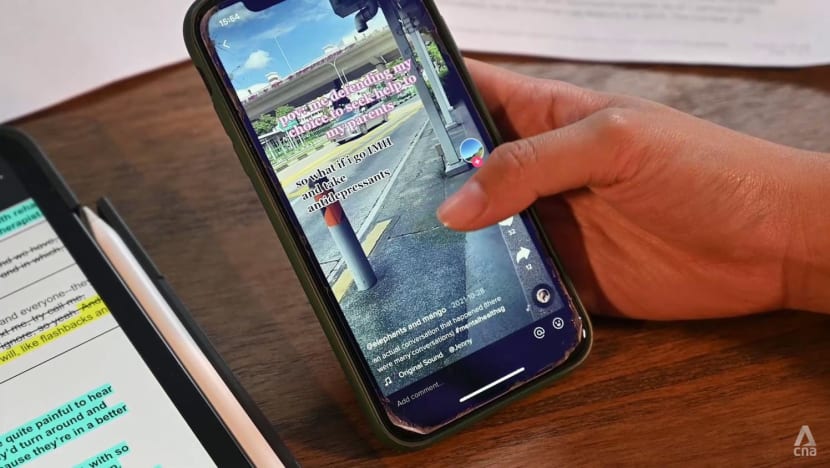More pain than happiness during therapy, but I hung on, says one youth. Here’s why you should too
Seeking help is a huge first step, but entering the mental healthcare system requires a lot of hard work. A youth survivor shares three tips on how to get more out of treatment.

SINGAPORE: Mental health stigma is still a major barrier to seeking help, although more youths and other survivors are bravely sharing their stories to break the silence.
It’s why I documented my experiences and treatment for complex post-traumatic stress disorder (C-PTSD) at the Institute of Mental Health on TikTok (@elephantsandmango). It was for the same reason that I agreed to be interviewed for CNA Insider’s deep dive into youth mental health.
I have chosen to remain anonymous because I want to protect my family’s privacy whilst being able to speak openly about the issues surrounding mental health. I find that it is difficult to do one without the other.
Seeking help – be it confiding in a trusted adult, tapping a service like the Institute of Mental Health’s Community Health Assessment Team, or approaching your nearest polyclinic – is a huge first step. But what next?
The “seek help” narrative can sometimes paint a picture in which all your troubles go away when you start therapy. It can oversimplify what entering the mental healthcare system truly entails – a lot of hard work.
Now that more people are beginning to seek help, we need to empower them with realistic expectations and practical information.
Here are three tips that helped me get the most out of treatment.
1. Find a psychologist you can connect with
When I met my first psychologist, I found her to be a kind lady who made me feel validated. However, I could not understand her because – through no fault of her own – she was not a native English speaker.
After the first session, I shyly shared with her my reservations. We decided to try for another session.
After the second session a week later, I realised it would be difficult to make it work. I was paying for therapy out of my own pocket at that time – each session cost S$57 after subsidies – and did not have the luxury of money to try and build a connection.

I had to wait a month to see a different psychologist, but the effort was worth it. I built a strong working relationship with my second psychologist, whom I have been seeing for two years.
American psychologist, researcher and author Michael J Lambert, renowned for his work on improving psychotherapy outcomes, argues that the patient-psychologist relationship is important for therapy to be effective.
In my experience, this makes perfect sense because psychologists process painful memories with us and advise us on techniques to move forward in life. The way they communicate their insights is as important as what they have to say.
What makes for a good connection with your psychologist?
A common way of gauging this is whether one sees positive changes after three sessions. If not, you should give feedback to the psychologist (more on this in point 3) and, by the fifth session, you could try finding someone else.
That said, if you’ve changed psychologist numerous times, perhaps it is worth reflecting on your approach to psychotherapy.
2. Worried about taking medication? Be open with your psychiatrist
There is significant social stigma and misinformation surrounding medication for mental conditions. I say this based on my own initial scepticism and the reactions of those around me, including my father.
He was worried I would develop a lifelong addiction to antidepressants. Another common worry is whether the medicine would compromise one’s daily functions.
I have had many conversations about medication with my psychiatrist.
Initially, I readily embraced the medication after doing some basic research. After a while, however, the fears from my father and self-doubt crept in.
At many points, I asked my psychiatrist why it was important for me to be on medication and whether it would be a lifelong prescription.
He shared the science behind selective serotonin reuptake inhibitors – SSRIs, the most commonly prescribed antidepressants – and mental illness.
He distinguished between dependency and addiction, and clarified that some patients may be able to slowly wean off the medication in the long run. Others may have to take it for life because their brains are more vulnerable to mental illness and would require it to be functional. (Think of it as a Type 1 diabetes patient’s dependence on insulin injections.)
In my case, we are currently working towards weaning off medication.
This was not vastly different from what I had read, but hearing it from him gave me more assurance. It was important for me to know what was happening to my body, explain to my father why I needed to be on the medication, and what to expect in the future.
WATCH: Are Young People Getting The Help They Need? | Confronting Youth Mental Health Part 2/2 (31:15)
It is also helpful to let your psychiatrist know how you are responding to the medication.
My body did not react well to the first prescription – while my mood was lighter, I was falling asleep whenever I sat down. I shared this with my doctor and the new prescription worked better – the new drugs lightened my mood without causing drowsiness.
My advice to those with the same doubts: Seek the knowledge and assurance you need. Do not be afraid to clear any doubts with your psychiatrist, and honestly share your experience with the medication.
3. If therapy is not working well or causing you pain, work through it with the experts
There are a variety of psychotherapy methods.
I started with exposure therapy which, in my experience, is a paradoxical therapy method that has peer-reviewed legitimacy. Initially, however, I was confused by it as I left most sessions feeling distressed.
I found myself dreading sessions and unwilling to recount traumatic memories. I also felt I was wasting my money on sessions and did not want to continue therapy. Yet, I knew that if I wanted to get better, I needed to work through this with my psychologist.

She explained the mechanics behind exposure therapy – that complex PTSD is fuelled by avoidance of traumatic memories, which causes them to surface intrusively through flashbacks and nightmares. Imaginal exposure – intentionally reliving the memory in a safe space with the psychologist – breaks this avoidance pattern.
After I understood the mechanics, I found myself motivated to go for sessions. I no longer felt like I was wasting time, money and emotions. I saw purpose in the initial discomfort. True enough, the intrusive memories subsided, and I was better able to cope with the trauma.
After a year of imaginal exposure therapy, however, I found myself getting bored. We had gone through most of the traumatic memories and I no longer felt as much distress.
Yet, I knew that I had so much more to unpack. Perhaps, I had had sufficient exposure to past traumatic incidents and needed a change in methods?
I broached this with my psychologist and we spoke about whether my boredom was an unconscious act of avoidance, or if I truly needed a change. Once she was certain it was the latter, she obtained my consent to raise this with her psychologist and psychiatrist colleagues at IMH’s trauma department.
To my relief, the first instinct of the team was not, “sigh, more work”. Rather, they rejoiced that I was advocating for myself. This is because complex PTSD patients have typically experienced prolonged domestic violence – thrashings by my mother were a feature of my childhood – and often have difficulty knowing and advocating for their needs.

I eventually changed to the schema therapy method and found it profoundly helpful for the next step in my recovery. Schema therapy is designed to break negative thought patterns arising from unmet needs, such as for connection, autonomy and assertion, early in life.
Finally, while I’ve urged fellow survivors to be pro-active in getting treatment for mental conditions, I recognise that certain factors are beyond patients’ control. Our public mental healthcare system faces a heavy load and waiting times are longer than before.
I also acknowledge that there are some who have felt re-traumatised by the system, be it through mis-diagnoses, insensitive comments made by therapists or the sheer waiting time causing one to feel abandoned.
For factors that are within our control, however, I hope these tips will be useful in getting a richer and more effective experience from therapy. All the best in your journey.
The writer is an undergraduate at the National University of Singapore. She was diagnosed with complex PTSD in June 2019 and completed psychotherapy treatment at the Institute of Mental Health in December 2021. She advocates for mental health recovery on TikTok @elephantsandmango and is known as Zoe in the CNA Insider documentary.
Where to get help:
Samaritans of Singapore Hotline: 1 767
Institute of Mental Health Helpline: 6389 2222
CHAT: www.chat.mentalhealth.sg/.
Singapore Association of Mental Health Helpline: 1800 283 7019
SAMH SAY-IT: 9179 4087 / 9179 4085 or samhsayit [at] samhealth.org.sg (samhsayit[at]samhealth[dot]org[dot]sg)
Club HEAL: 6899 3463
TOUCHLINE: 1800-377-2252 or @doyoumindsg
Mindline: www.mindline.sg
Other mental health mobile apps: CARA Unmask, Safe Space, Intellect, MindFi, Myloh
You can also find a list of international helplines here. If someone you know is at immediate risk, call 24-hour emergency medical services.
















